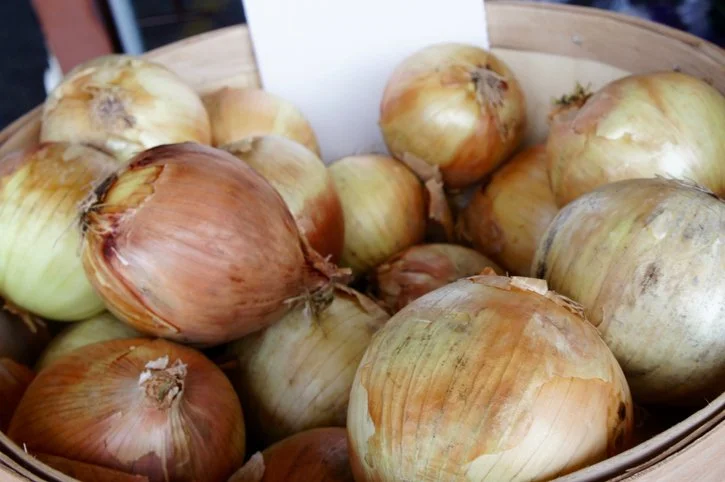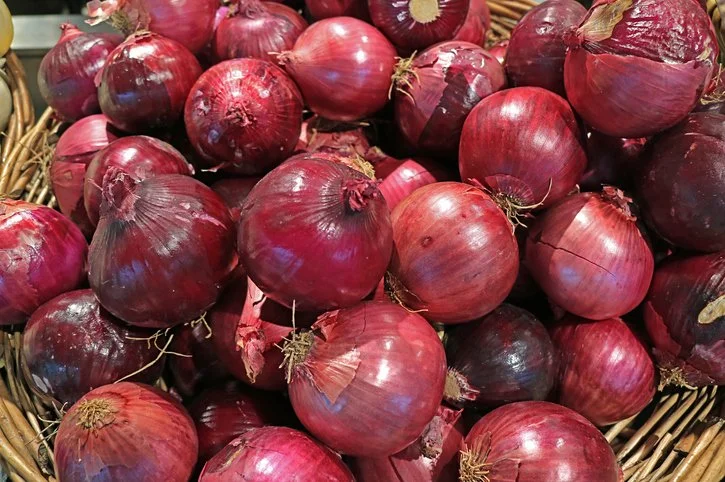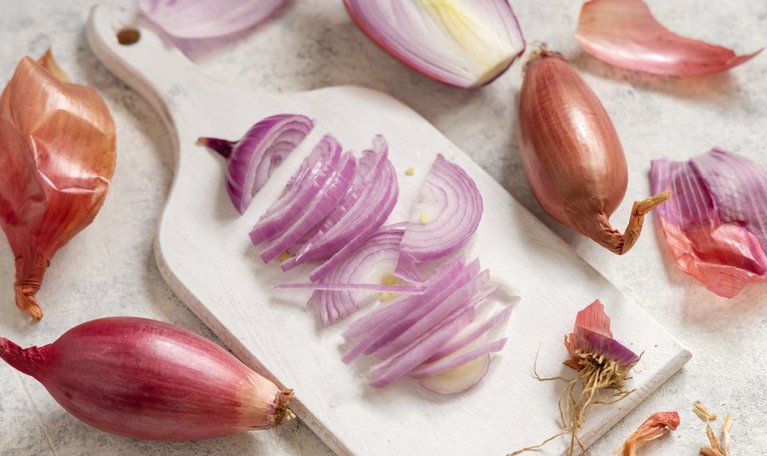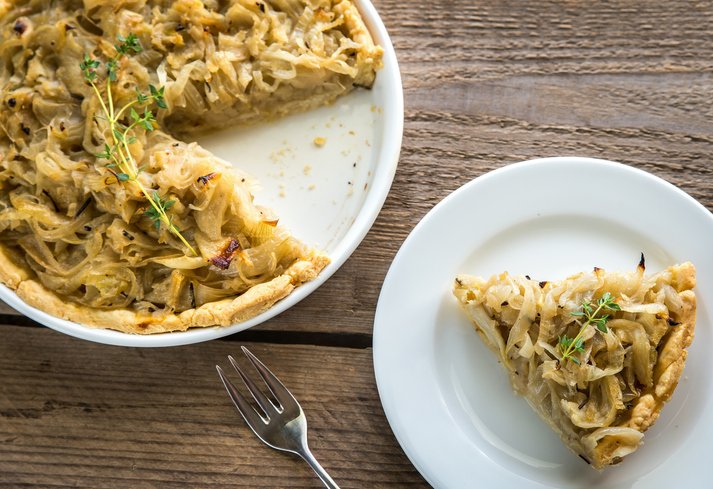What’s in Season: Onions – Types, Benefits, and Nutrition
Discover > Texas Home Cooking > What’s in Season: Onions – Types, Benefits, and Nutrition
Onions 101: Everything You Need To Know About Onions
Onions (What wine goes well with onions?) belong to the same family of plants that include garlic, chives (how long do chives last?), and leeks. If you notice a pattern, all of the plants in the family contain that nice pungent odor that lends well to cooking. The allium family of plants has been cultivated for centuries because of that pungent smell and sweet flavor.
What many people don't know is that the types of onions, like the rest of the plants in the allium family have various medicinal properties, vitamins, minerals, and other good stuff that has been known to promote health.
The medicinal properties of onions have been known for centuries, just like garlic, onion has been used to treat a wide range of ailments ranging from mouth sores all the way to heart disease, a claim that has been also published on the National Library of Medicine here.
Before we go over the various nutritional and health benefits of onions, here are some amazing facts and information about onions that you should need to know about.
Varieties of Onions
No self-respecting kitchen would be found without onions! Onions take food just beyond nutrition and takes it to the next level. Sure they aren't essential to any dish (many chefs would stone me for saying that), meaning that many dishes will still taste good if onion is removed, but they wouldn't taste AS GOOD. In fact, I don't know a cuisine in the world that doesn't make use of onions, and I know a lot of them! Let's take a look at the different types of onions shall we?
Yellow onions
These are the most common type of onions out there. If you see a recipe calling for onions without specifying what type (shallot, red, white, etc...) then it's a safe bet that the recipe is calling for the use of yellow onions. Yellow onions are characterized by their heavy brown parchment-like skin covering up the white flesh underneath.
It has a strong pungent flavor and aroma that mellows out when cooked and imparts a pleasing flavor to whatever is being prepared. Yellow onions truly stand out when caramelized, adding that signature sweet onion taste to many dishes. French onion soup anyone?
Yellow onion culinary use - every recipe
Sweet Onions
A lot of us confuse sweet onions with yellow onions (I even know someone who lumps them all together and calls them white onions interchangeably) but sweet onions are known for their higher sugar content makes them perfect for caramelization. Sweet onions also have a pale yellow color (versus white from yellow onions, yeah, I know, this is why they get interchanged sometimes) and lighter skin covering.
Milder and sweeter in taste, sweet onions are also great for use as garnishes and other raw applications. Some well-known sweet onion varieties are Vidalia, Maui, and Walla Walla sweet onions. The bulbs of sweet onions look a bit "flatter" than the bulbs of yellow onions that are uniformly round.
Sweet onion culinary use - Caramelized applications, relishes, salads, and garnishes
Red Onions
Characterized by their deep red and purplish color, it's impossible to mistake red onions for something else. Red onions are often seen on salads and sandwiches, usually raw, not just because of their peppery spicy taste but for its amazing purplish-red color as well! They're also great for pickling (again, not only because of their taste but because of their color as well) and for roasting and grilling which brings out the sweetness and pleasing smokey flavor in them.
Red onion culinary use - Pickling, garnish
Shallots
Shallots have smaller bulbs than other onion varietals. Usually no larger than a thumb, these pungent and garlicky flavored onions pack a very intense flavor and are prized in many French kitchens. Although not as popular in Texan kitchens, they should definitely have a place in your kitchen if you want to add a garlic-onion punch to your dishes. They're best used in sauces and in vinaigrettes. You can find shallots in almost any supermarket and during June and July, many farmers markets around Texas!
Shallot culinary use - Dressings, vinaigrettes, and sauces
Green Onions, Scallions, and Spring Onions
These are onions that have not yet had an opportunity to form a bulb. Milder in flavor than fully grown bulbs, green onions, scallions, and spring onions are popular in many Asian and Mexican dishes (especially tacos and pico de Gallo) not only for their mild flavor but for the fresh green color that they impart as well.
Green Onion, Scallion, Spring Onion culinary use - Asian and Mexican Dishes
Leeks
Although in the same family as onions, leeks do not form bulbs. They look like giant spring onions or green onions. They have a very sweet onion flavor that's perfect for soups (What wine goes well with soups?), pasta, stews, and more! But if you ask me, the Japanes and Koreans have it right when they grill the leeks! This brings out the sweetness and adds a pleasant smokey flavor to it that's unbelievable and you should try at least once!
Leek stalks, green vegetables, local produce market.
Onion Nutrition Facts and Onion Health Benefits
Not only do onions impart amazing flavor to whatever dish they're added to, well, not ice cream, but they actually have a host of health benefits well! Not less than 6, yes six (and there may even be more) studies on the National Library of Medicine here, here, here, here, here, and here, show an inverse correlation of cancer and onion/allium family consumption!
While they're not meant to be munched on like fruits or other vegetables, onions have a very low-calorie count. With only 40 calories for every 3.5 ounces, you can add a whole bunch of flavor to your dishes without the added calories!
By fresh weight, onions are basically 89% water, 9% carbohydrates, and roughly 1.7% fiber plus a small amount of fat and protein.
While not overly abundant, onions contain decent amounts of vitamin c, folate (vitamin b9), vitamin b6, and potassium. Other plant compounds that onions contain that offer health benefits are anthocyanins (only found in red/purple onions) that are extremely powerful antioxidants. Coincidentally, anthocyanins are the compounds that give red and purple onions their pleasing color.
Quercetin is another antioxidant flavonoid that's found in onions that can lower blood pressure. There are also sulfur compounds in onions (which explains their pungent smell and flavor) that may protect against cancer and other diseases. Thiosulfinates are also a type of sulfur compound in onions that inhibit the growth of microorganisms. In order of the richness of antioxidants, yellow, red, and white. In fact, yellow onions contain as much as 10 times the antioxidants that white onions have!
How to Choose Bulb Onions
For bulb onions like yellow, white, and red onions, choose the ones with dry and papery skin.
Avoid any onion that have soft spots and moisture.
The dryer and "crisper" the skin feels the fresher the onion is.
Look for onions that are firm and heavy for their size.
Avoid bulb onions that have a strong smell to them, this smell comes from bruises in the onion that's causing the juices to leak out.
While they look nice and fresh, also avoid bulbs that have started to sprout as these will rot soon
How to Store Bulb Onions
Store your bulb onions in a cool and dark place. Properly stored, they can last weeks, months, and even up to a year according to The Chef's Garden
While it may sound like the right thing to do, avoid storing whole bulb onions in the fridge as this will cause it to rot faster
Once peeled and cut, bulb onions can be stored in the fridge for up to ten days. Make sure to store them in airtight containers so that the onion smell won't contaminate everything else in the fridge and make your onions last longer as well.
Onions can also be frozen for a couple of months but make sure to use it after thawing it out and throw them away if not used. Re-freezing thawed out frozen onions is not recommended.
How to Choose Spring/Green/Scallions
/Leeks
The stalks should be crisp, firm, and smooth and without any signs of wilting
Avoid any green onion that have discoloration on their stalks
The bottom white parts of the stalks should be firm and unblemished
How to store spring/green/scallions/leeks
Unlike bulb onions, green onions should be stored in the fridge, specifically in the crisper drawer, wrapped in a slightly damp paper towel for up to two weeks.
If you're planning on using your green onions immediately, they'll be fine on the kitchen counter for up to two days
If you plan on freezing your green onions, chop them up before placing them in a freezer-safe container and they should last for a few months.
Onion Uses and Preparation
Onions are a staple in the kitchen. They are used in many different ways and are a wonderful addition to any meal.
Onion uses include:
Stir fry: Onions can be added to vegetable or meat stir fry dishes to add flavor and sweetness.
Mashed potatoes: Mashed potatoes made with onions will have a more complex flavor than those without them.
Casseroles: Add chopped onions to casseroles for added flavor and moisture.
Soups: Add sliced onions to soups for added flavor and nutrition.
No matter how you slice it, onions are a kitchen essential and we should use them in every way possible! They're essential. In fact, we use them every day and in every dish. We love their natural sweetness, fine texture, and remarkable health benefits. In fact, we wouldn't have it any other way. I mean, even Chuck Norris loves onions (don't tell him we said that!).
Onion Recipes
Below is a list of some of my favorite onion recipes.
Onion Soup
This soup is one of my favorite ways to eat an onion. It's simple and quick to make, but it tastes so good!
Onion soup is a traditional French dish, often served at the beginning or end of a meal. It is simple to prepare, requiring only onions and broth to be cooked on the stovetop.
The original recipe called for both butter and flour (how long does flour last?) to be added to the broth before serving. This was done in order to prevent the onion soup from becoming too dry. However, adding both ingredients has been replaced with only one of them over time.
In addition to being rich in flavor, onion soup is also low in calories and fat. If you are looking for a light meal that won't fill you up too quickly, this may be just what you need! And the best part? It's super simple to make!
1 1/2 cups chopped onion
2 tablespoons butter
1/2 cup flour
1/2 cup chicken broth (how long does chicken broth last?), reduced-sodium, or water
Salt and pepper to taste
In a large skillet over medium heat, sauté the onion in the butter until tender and golden brown. Add the flour and stir for about 20 seconds. Slowly add the chicken broth, stirring constantly until thickened. Season with salt and pepper to taste.
Onion Tart
If you love tarts, then this one is for you! You can make it as fancy or simple as you would like. My favorite part about this recipe is the filling - it's so creamy and delicious! This recipe is adapted from a traditional French onion tart. The pastry shells are made with flour, butter and water, then baked until golden brown. The filling is made with onions, cheese and thyme.
Ingredients
For the pastry
1 cup (250 grams) all-purpose flour
1/2 cup (120 grams) cold unsalted butter, cubed
3/4 cup (175 ml) cold water
For the filling
1 medium onion, thinly sliced into rings
2 tablespoons olive oil
1 tablespoon dried thyme (how long does dried thyme last?) leaves
2 ounces mozzarella cheese, shredded (40 grams)
To make the pastry, place flour and butter in a food processor. Pulse until mixture resembles breadcrumbs. Add water, and pulse again until dough is smooth. Roll out between pieces of parchment paper, and set aside in the fridge to rest for 30 minutes. To make the filling, sauté onions in olive oil with thyme leaves until they are softened and golden. Pre-heat oven to 200°C. Roll out dough on a lightly floured surface until it is 1/4 cup (50 cm) larger than an 8-inch (20 cm) pie pan or tart dish. Grease pie pan or tart dish with butter, then line the base with the rolled out dough. Fill with the sautéed onions, then top everything off with cheese. Place in oven and bake for 20–25 minutes until golden brown.
What's your favorite onion recipe? Let us know in the comments below! For more information about onions, you can go to the National Onion Association website and learn more about this wonderful vegetable!












